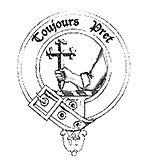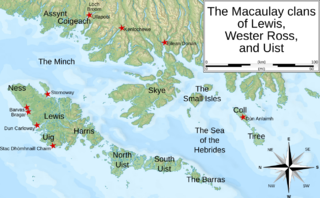Related Research Articles

Flora MacDonald is best known for helping Charles Edward Stuart evade government troops after the Battle of Culloden in April 1746. Her family had generally backed the government during the 1745 Rising, and MacDonald later claimed to have assisted Charles out of sympathy for his situation.

North Uist is an island and community in the Outer Hebrides of Scotland.

A Scottish clan is a kinship group among the Scottish people. Clans give a sense of shared heritage and descent to members, and in modern times have an official structure recognised by the Court of the Lord Lyon, which regulates Scottish heraldry and coats of arms. Most clans have their own tartan patterns, usually dating from the 19th century, which members may incorporate into kilts or other clothing.

Eigg is one of the Small Isles in the Scottish Inner Hebrides. It lies to the south of the island of Skye and to the north of the Ardnamurchan peninsula. Eigg is 9 kilometres long from north to south, and 5 km (3 mi) east to west. With an area of just over 3,000 ha (11.6 sq mi) it is the second-largest of the Small Isles after Rùm. The highest eminence on Eigg is The Sgùrr, which is formed from the Sgurr of Eigg Pitchstone Formation, which erupted into a valley of older lavas during the Eocene epoch.

Clan Donald, also known as Clan MacDonald or Clan Mc Donald, is a Highland Scottish clan and one of the largest Scottish clans. The Lord Lyon King of Arms, the Scottish official with responsibility for regulating heraldry in that country, issuing new grants of coats of arms, and serving as the judge of the Court of the Lord Lyon, recognises under Scottish law the High Chief of Clan Donald. Historically the chiefs of the Clan Donald held the title of Lord of the Isles until 1493 and two of those chiefs also held the title of Earl of Ross until 1476. Queen Mary of Denmark is member of Clan Donald.
Arisaig is a village in Lochaber, Inverness-shire. It lies 7 miles south of Mallaig on the west coast of the Scottish Highlands, within the Rough Bounds. Arisaig is also the traditional name for part of the surrounding peninsula south of Loch Morar, extending east to Moidart. Etymologically, Arisaig means "safe bay". It lies in the Scottish council area of Highland and has a population of about 300.
Alasdair mac Mhaighstir Alasdair, legal name Alexander MacDonald, or, in Gaelic Alasdair MacDhòmhnaill, was a Scottish war poet, satirist, lexicographer, and memoirist.

Clan MacDonell of Glengarry, also known as Clan Ranald of Knoydart & Glengarry is a Highland Scottish clan and is a branch of the larger Clan Donald. The clan takes its name from River Garry where the river Garry runs eastwards through Loch Garry to join the Great Glen about 16 miles (25 km) north of Fort William, Highland. The progenitor of the MacDonells of Glengarry is Reginald, 4th great-grandson of the warrior Somerled. The clan chief is traditionally designated as the "Son of Alexander's son".

Clan MacIntyre (McIntyre) is a Highland Scottish clan. The name MacIntyre, means "son of the carpenter.” It is most commonly said to descend from Maurice Mac Neil a nephew of Somerled, the great 12th century leader of the Scottish Gaels. Through an ingenious strategy, Maurice secured the marriage of Somerled to the daughter of the King of Mann and the Isles, thus greatly increasing Somerled's territories. At an unknown date the clan journeyed from the Hebrides to the Scottish mainland where the chiefs established their home at Glen Noe, in Ardchattan Parish, on the east side of Loch Etive.

Clan Macdonald of Clanranald, also known as Clan Ranald, is a Highland Scottish clan and a branch of Clan Donald, one of the largest Scottish clans. The founder of the Macdonalds of Clanranald is Reginald, 4th great-grandson of Somerled. The Macdonalds of Clanranald descend from Reginald's elder son Allan and the MacDonells of Glengarry descend from his younger son Donald.

Clan Macdonald of Sleat, sometimes known as Clan Donald North and in Gaelic Clann Ùisdein, is a Scottish clan and a branch of Clan Donald—one of the largest Scottish clans. The founder of the Macdonalds of Sleat was Ùisdean, or Hugh, a 6th great-grandson of Somerled, a 12th-century Lord of the Isles. The clan is known in Gaelic as Clann Ùisdein, and its chief's Gaelic designation is Mac Ùisdein, in reference to the clan's founder. Both the clan and its clan chief are recognised by the Lord Lyon King of Arms, who is the heraldic authority in Scotland.

Clan MacDonald of Dunnyveg, also known as Clan Donald South, Clan Iain Mor, Clan MacDonald of Islay and Kintyre, MacDonalds of the Glens (Antrim) and sometimes referred to as MacDonnells, is a Scottish clan and a branch of Clan Donald. The founder of the MacDonalds of Dunnyveg is Eòin Mòr Tànaiste Mac Dhòmhnaill, a son of Iain Mic Dhòmhnaill and Margaret Stewart of Scotland, daughter of King Robert II. Members of the clan actually pronounced and spelled their name M'Connall due to the Gaelic pronunciation of the name Mac Domhnuill thus giving rise to the surname McConnell and its variants. While historically recognised as a clan by the Court of the Lord Lyon, it is now an armigerous clan as it no longer has a chief. The last chief was Sir James MacDonald, 9th of the Clan MacDonald of Dunnyveg or Clan Donald South, who died in London in 1626.

Bohuntine is a settlement located close to Roybridge, in Lochaber, within the Scottish Highlands, and is in the Highland Council area.

The Macaulay family of Uig in Lewis, known in Scottish Gaelic as Clann mhic Amhlaigh, were a small family located around Uig on the Isle of Lewis in the Outer Hebrides of Scotland. There is no connection between the Macaulays of Lewis and Clan MacAulay which was centred in the Loch Lomond area, bordering the Scottish Highlands and Scottish Lowlands. The Macaulays of Lewis are generally said to be of Norse origin because of the etymology of their surname and also because of the islands' Viking Age past. However, a recent analysis of the Y-DNA of men with Scottish surnames has shown that a large number of Hebridean Macaulays are of Irish origin. In the 17th century, however, tradition gave the Macaulays an Irish origin. By the end of the 16th century the dominant clan on Lewis was Clan Macleod of The Lewes. Other notable Lewis clans were the somewhat smaller Morrisons of Ness and the even less numerous Macaulays of Uig. The Macaulays were centred in the area surrounding Uig on the western coast of Lewis, and had a deadly, long-standing feud with the Morrisons, whose lands were located on the northern coast around Ness. Today the Lewis surname Macaulay is considered to be a sept name of the Macleods of Lewis. There are two other nearby clans of Macaulays who may, or may not, be connected to the Lewis clan—the Wester Ross Macaulays, and the Uist MacAulays.

Dalelia or Dalilea is hamlet on the north shore of Loch Shiel in Acharacle district of Argyll, Scottish Highlands and is in the Scottish council area of Highland. Kinlochmoidart is to the north. The alternate Gaelic name "Dàil an Leigh" has been suggested but this is believed to be a folk etymology for Dàil Eileadh.

The Highland Clearances were the evictions of a significant number of tenants in the Scottish Highlands and Islands, mostly in two phases from 1750 to 1860.
Iain Mac Fhearchair (1693-–1779) was a Scottish Gaelic-speaking Bard and seanchaidh "who lived and died in the island of North Uist." Later in his life, Iain served as Chief Bard to the Chief of Clan MacDonald of Sleat, had a friendship with Alasdair Mac Mhaighstir Alasdair, and made an appearance in the Ossianic controversy surrounding the poet James Macpherson.

John MacDonald of Glenaladale was a Scottish-born soldier, land owner and colonizer. He played an important role in bringing Scottish settlers to Prince Edward Island, Canada.

Alexander Macdonald, 17th of Keppoch was a Scottish Jacobite and clan chief who took part in both the 1715 and 1745 Jacobite risings. He was killed at the Battle of Culloden leading a regiment composed largely of members of his clan, the MacDonalds of Keppoch.

The Ship of the People is a moniker given to the Irish ship William, which played a key role in a Scottish human trafficking scandal in 1740, when over a hundred men, women and children were kidnapped from the Hebrides with the intention of selling them as indentured servants in the Thirteen Colonies. The scheme was devised by Norman MacLeod of MacLeod, chief of Clan MacLeod, who was in deep debt at the time, and Sir Alexander MacDonald, chief of Clan MacDonald of Sleat, and was carried out by tacksman Norman MacLeod of Unish and skipper William Davidson. En route to America, a landing in Ireland was made, where several victims attempted to escape, alerting local authorities and attracting the attention of the British government. MacLeod and MacDonald successfully denied involvement in the incident and escaped prosecution, while the victims of the scheme were set free and mainly settled in Ireland for the remainder of the lives.
References
- ↑ "Ceannardan poileataigeach a' dèanamh luaidh air Diùc Dhùn Èideann". Naidheachdan A' BHBC. 12 April 2021 – via www.bbc.com.
- ↑ "Dictionaries of the Scots Language:: DOST :: takkisman".
- ↑ Scotland, Highland and Agricultural Society of; Scotland, Royal Highland and Agricultural Society of (1 January 1828). "Dictionarium Scoto-celticum: A Dictionary of the Gaelic Language; Comprising an Ample Vocabulary of Gaelic Words ... with Their Signification and Various Meanings in English and Latin ... and Vocabularies of Latin and English Words with Their Translation Into Gaelic. To which are Prefixed, an Introduction Explaining the Nature, Objects and Sources of the Work, and a Compendium of Gaelic Grammar". W. Blackwood – via Google Books.
- 1 2 Samuel Johnson, A Journey to the Western Islands of Scotland (1775)
- ↑ Alexander Nicholson, History of Skye (3rd edition, Islands Book Trust, 2012), at pages 127 to 128.
- ↑ James Mitchell, The Scotsman's Library (1825), at page 260
- 1 2 Hunter, James (1999)., Last of the free: a millennial history of the Highlands and islands of Scotland., Mainstream Pub